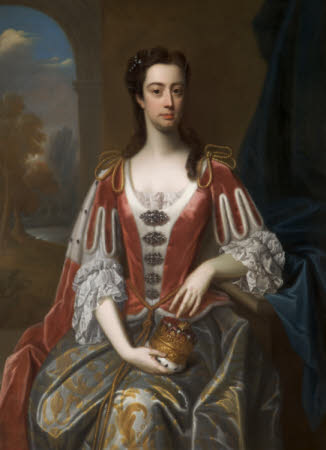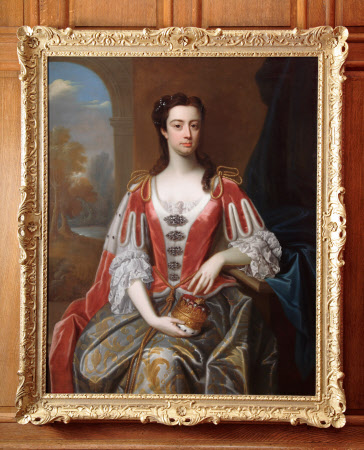Dorothy Wrighte, Countess of Stamford (d.1738)
attributed to Enoch Seeman the younger (Gdańsk c.1694 – London 1744)
Category
Art / Oil paintings
Date
circa 1720 - 1725
Materials
Oil on canvas
Measurements
1016 x 1270 mm (40 x 50 in)
Order this imageCollection
Dunham Massey, Cheshire
NT 932399
Caption
Dorothy Wrighte was one of the four daughters (and six sons) of Sir Nathan Wrighte, Kt (1654-1721), Lord Keeper of the Great Seal. She married Harry Grey, 3rd Earl of Stamford (1685-1739), of Dunham Massey, on 6th July 1704. Their marriage was a tempestuous one. According to Dr Wilke’s diary (November 18th 1739): “by his [the Earl’s] ill usage she was twice forced to leave him”, and after the birth of their second son the couple separated permanently. The Earl’s behaviour became increasingly erratic – suffering “no man to look upon him but made all his servants come into and go out of the room with their backs towards him”. Their son Harry Grey, became 4th Earl of Stamford (1715-1768).
Summary
Oil painting on canvas, Dorothy Wrighte, Countess of Stamford (d.1738), attributed to Enoch Seeman (Danzig c.1689/90 - London 1744/45), circa 1720/25. Three-quarter length, seated, in a countess’s cloak over a scarlet bodice with ermine-trimmed epaulettes and looped cords, above a court dress, holding a coronet in her right hand on her lap.
Full description
Dorothy Wrighte, one of the four daughters (and six sons) of Sir Nathan Wrighte, Kt (1654-1721; knighted in 1696/7), Lord Keeper of the Great Seal (whose splendid monument, uninscribed, is in the church that he built at Gayhurst, Bucks), and Elizabeth, daughter of George Ashby of Quenby, Leics, married Harry Grey, 3rd Earl of Stamford (1685-1739) on 6th July 1704. Their marriage was a tempestuous one. According to Dr Wilke’s diary (November 18th 1739): “by his [the Earl’s] ill usage she was twice forced to leave him” and after the birth of their second son the couple separated permanently. The Earl’s behaviour became increasingly erratic – suffering “no man to look upon him but made all his servants come into and go out of the room with their backs towards him”. At one point he also took an aversion to lime: “so built a little house of wood frames and straw”, and a subsequent riverside complex with a wall 8 feet high was thought intended to entrap the Countess – “but if this was his scheme she very wisely disappointed him”. Their son Harry Grey, became 4th Earl of Stamford (1715-1768). The portrait of the sitter’s husband, seen by Musgrave in 1797, has not resurfaced. Their two portraits were presumably always at Enville, antedating as they do the marriage of the 4th Earl with Lady Mary Booth, hence their not appearing in any inventory of the pictures at Dunham Massey.
Provenance
probably one of the pair of an unattributed portraits of the 3rd Earl of Stamford and ‘Dorothy Wrighte, Wife to the 3rd E. of Stamford, Dau.r to Sir Nathan Wrighte, Lord Keeper’, recorded at Enville Hall by Sir William Musgrave in 1797. Subsequently in the Enville Hall picture list of 1905 as: “Jervis. Portrait of a Countess”. And, in another hand: “Rich dress red body ermin [sic] trimmed, gold cord epaulettes or knots, described on back as Sir J. Thornhill, 1676, Countess of Warrington.” In a photograph of the Ballroom at Enville of c.1910, the portrait can be seen hanging as the centre of one of three portraits in the middle register to the right of the arch. To the left of her is the Hudson of the 4th Earl, in those days misidentified as her husband, the 3rd Earl. The confusion over artist and identity indicated by the inscription formerly on the back of the picture makes it easier to understand that in the first of the two Foley-Grey/Enville Hall sales at Christie’s, on 15th June 1928, it was catalogued, as lot 37, as: “C. JERVAS. PORTRAIT OF MARY, COUNTESS OF WARRINGTON In Peeress’s robes, seated, holding a coronet 49 ¼ in. by 39 ½ in.” It appears to have been exported to the U.S.A. then or soon after. At some point it passed into the ownership of Mr. Breck Platner of Bratenahl, Ohio (though, curiously, the condition report gave the owner as Mr. Warren Miller), by whom it was sold to the National Trust in 2002, for £9,500.
Makers and roles
attributed to Enoch Seeman the younger (Gdańsk c.1694 – London 1744), publisher attributed to Jonathan Richardson the elder (London 1665 – London 1745), publisher

